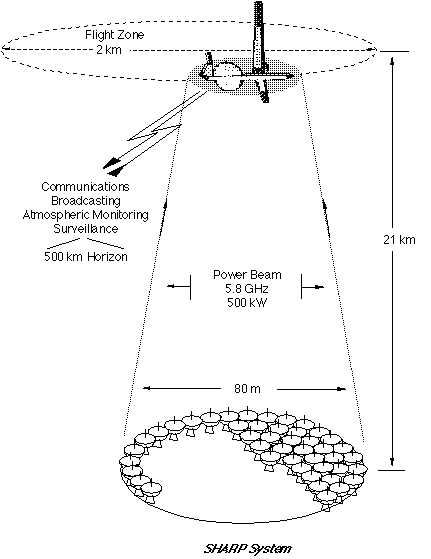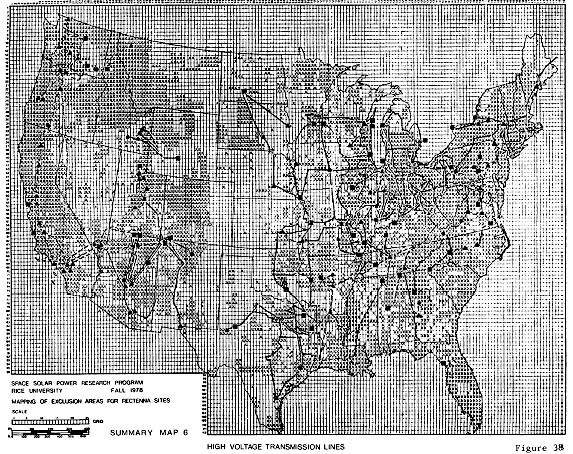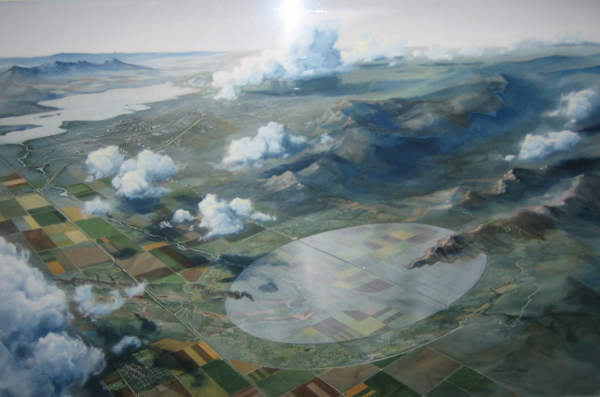|
Mainland High School
Cutting the Cord: ISTF 07-1726 |
||
|
Home
Introduction Components One Two  Product Product
Three Microwave Research W. C. Brown Generators History Phased Arrays Properties Rectennas Semiconductors Solar Satellites Superconductors Moon Research Colonization Helium-3 Fusion Geography Mining Resources Project Assessment Bibliography Glossary Team |
Rectennas
The rectifying antenna (rectenna) was originally invented and built by William C. Brown in the 1960s. The most common receiver for microwave power transmission is a rectifying antenna or a rectenna. These rectennas operate with a mesh of Schottky-barrier diodes and any type of antenna. A rectenna can be constructed from an antenna, a diode rectifier, and a DC bypass filter. The final output of the rectenna is DC power.
The microwaves transmitted from a satellite, or in our case a station on the moon, would be received by a large array of rectennas. The received microwave frequencies are in a range from 2-18 GHz. The diodes would be used to absorb and convert the high power frequencies into low frequency DC power. This DC power is then collected by a DC voltmeter. There have been many experiments in which the RF-DC conversion efficiency was above 85%. The efficiency of the RF-DC conversion depends on the amount of power input and connected load. If the input and the connected load are not at their optimum, then the efficiency drops dramatically. The SHARP (Stationary High Altitude Relay Platform) was an airplane with a receiving rectenna on its tail end. This rectenna received transmitted microwave energy to power the airplane. Brown was present to witness its first flight. It would have the ability to fly 21 kilometers up in the air, and its transmitted signals would reach a diameter of 600 kilometers. With the power transmitted from a large array on the ground, the SHARP would be able to fly for many months. The airplane was designed to be used for relaying telecommunications, surveying, and monitoring. This map was prepared in October 1978 for the US Department of Energy, Satellite Power System Project Office. It represents the ideal locations to erect 60 rectennas that could be used to collect microwave energy beamed to the surface by orbiting satellites. The solid lines represent lines that would connect the rectennas output to the power grid to distribute the energy to the local population. If this system were to be extended to other nations, those with limited available land areas, including both Japan and Europe, could consider building a rectenna on the open sea. Unfortunately it would be much more expensive. As seen in the picture above, it is expected that communities would still be able to use the land under the rectennas for agricultural needs. 9th Australian Symposium on Antennas - Development of Rectenna for Microwave Power Reception http://www.ict.csiro.au/asa/asa05/ASA05_paper_036_final.pdf DoE/NASA - Satellite Power System (SPS) Mapping for Exclusion Areas for Rectenna Sites http://www.nss.org/settlement/ssp/library/1978DOESPS-MappingOfExclusionAreasForRectennaSites.pdf (pg 100) Friends of CRC - SHARP http://www.friendsofcrc.ca/Projects/SHARP/sharp.html IEEE Xplore - Recycling ambient microwave energy with broad-band rectenna arrays http://ieeexplore.ieee.org/Xplore/login.jsp?url=/iel5/22/28503/01273745.pdf?arnumber=1273745 Journal of Radioelectronics - High Power Converter of Microwaves into DC http://jre.cplire.ru/jre/sep99/1/text.html Space Future - Equitorial Times No.4 http://www.spacefuture.com/power/equatorialtimes/4.shtml Space Studies Institute - SSI Sample Slides http://ssi.org/?page_id=14 URSI - Supporting Document for the URSI White Paper on Solar Power Satellite Systems http://www.ursi.org/WP/SupportingDocument1.pdf (pg 44) University of Maryland - CPSP 118G Earth, Life, and Time http://www.wam.umd.edu/~sscheff/WEBSITE/fieldtrip2.html |



